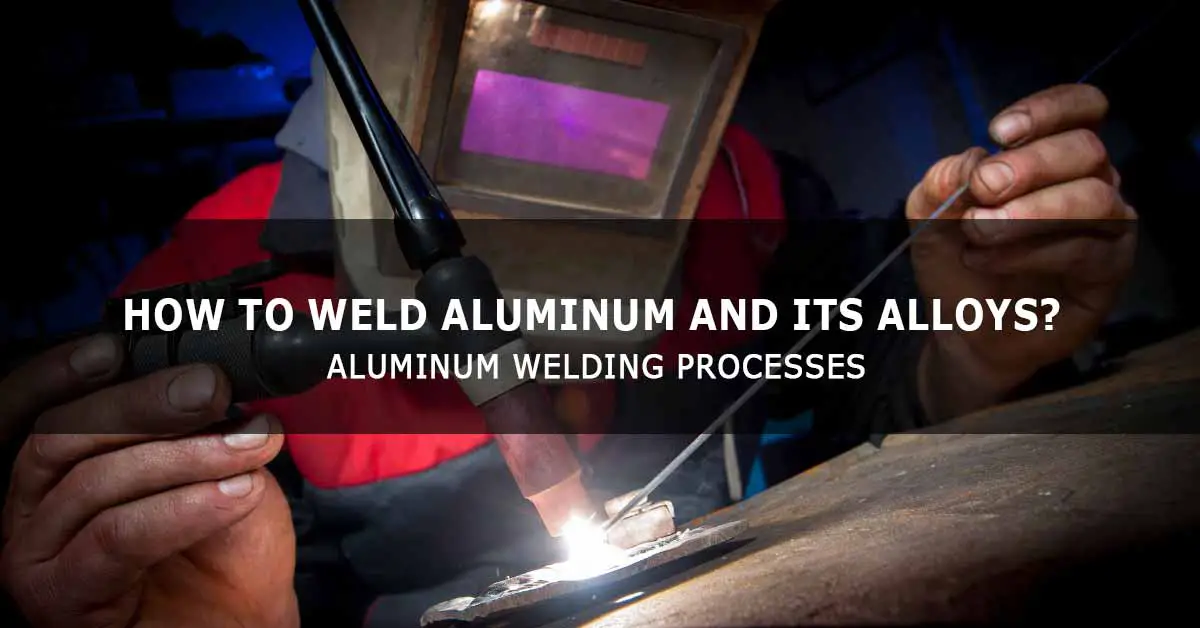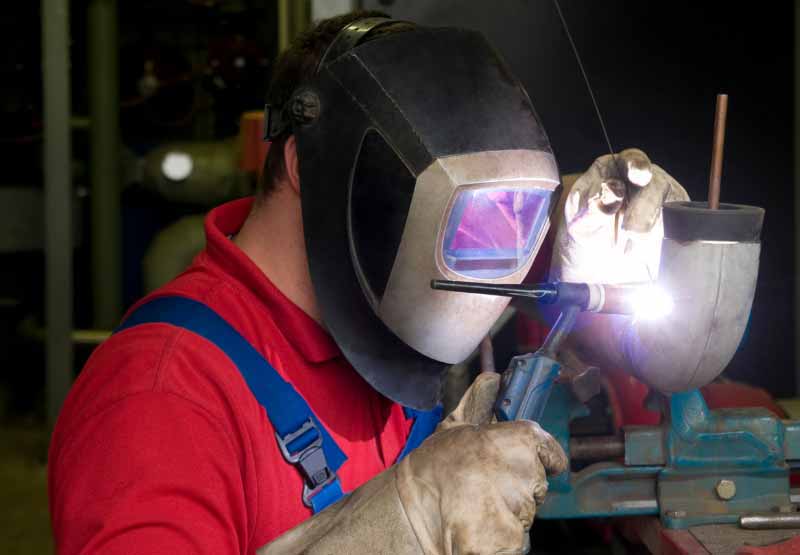Aluminum is a soft metal and has a low melting temperature. You can use more than one welding process to weld aluminum. However, you have to adopt the correct techniques to do it.
This article discusses why welding aluminum is difficult and the different welding processes you can use to do aluminum welding. Are you ready?
Is welding aluminum difficult?
Welding aluminum is a little tricky but not impossible. It can pose a challenge to all welders, including experienced welders. The best way is to learn the skill of aluminum welding and keep practicing till you become perfect.
Following are the issues with welding aluminum that you should take care of:
- Aluminum is a popular metal due to its lightweight and anti-corrosion properties. However, the same properties and low melting point make aluminum welding tricky.
- Aluminum reacts with atmospheric oxygen, forming an oxide coating on its surface. The melting point of pure aluminum is 1220º F (660º C), and the melting point of aluminum oxide is 3762º F (2072º C). Due to this difference in melting temperature, aluminum cannot be welded without removing this protective coating of aluminum oxide.
- The high thermal conductivity and the low melting point of aluminum give limited workability for welding it. The thermal energy created during welding gets dispersed very fast compared with steel. This creates bottlenecks for maintaining proper weld penetration.
- When aluminum is molten, it absorbs hydrogen, and the absorption rate increases with the temperature. Hydrogen can come from the moisture in the air, the workpiece, or the wire electrode. When the weld pool solidifies, hydrogen escapes leaving a porous and weak weld bead.
- Aluminum is a susceptible metal. The dirt, atmospheric air, and moisture can contaminate the weld pool during welding. Oxygen in the air can cause oxide formation and create quality issues during multi-pass welding.
- Welders should always strike a balance between weld penetration for a strong weld and burning off aluminum since aluminum has a low melting point.
- When aluminum is molten, it is vulnerable to impurities, which can make the weld weak and porous.
Why is welding aluminum perceived as complex?
We have discussed some of the issues related to aluminum welding in the previous paragraphs. Now, let us compile a list of properties of aluminum that makes it difficult to weld:
Aluminum is a soft metal and is extremely sensitive to the oxygen content in the atmospheric air. Aluminum stored for a sufficient time will have a layer of aluminum oxide on its surface.
Pure aluminum melts at 1220º F (660º C) and the aluminum oxide at 3762º F (2072º C). This difference in their melting temperature makes removing the aluminum oxide coating from the metal surface mandatory before welding.
The molten aluminum weld pool absorbs hydrogen, and the absorption rate increases with the temperature (the source of hydrogen is moisture on the workpiece, filler wire, or air). When the weld pool solidifies, the hydrogen escapes leaving behind a porous weld bead.
Aluminum is a sensitive metal easily affected by dirt, atmospheric air, and moisture. Molten aluminum weld pool can react with oxygen in the air, and an oxide layer can build up on the weld. This obstructs multi-pass welding (oxide layer to be removed).
Welders work with different thicknesses of aluminum, and it becomes a tight rope walk balancing the welding heat between good weld penetrations and avoiding burning aluminum metal.
Aluminum welding is difficult, but the happy note is that “it is not impossible.” You can learn the techniques of welding aluminum and become perfect in it.
Welding processes used for welding aluminum
You can weld aluminum using the following welding processes:
- Gas Tungsten Arc Welding or Tungsten Arc Welding (GTAW/TIG).
- Gas Metal Arc Welding or Metal Inert Gas welding (GMAW/MIG).
- Gas (oxyacetylene) welding.
- Laser beam welding, electron beam welding, resistance welding, and friction stir welding.
- Welding processes that use a flux are not recommended for welding aluminum. If you weld aluminum with SMAW/stick welding, FCAW, and submerged arc welding, the resulting weld can be irregular, defective, and with spatters. However, some welders choose stick welding to do repair welding at the worksite when there is no alternative.
Let us discuss some of the welding processes here, but before that, let us know how to prepare the workpiece for welding.
Preparing for the weld
Prepare the workpiece for welding by doing the following:
- Clean the aluminum workpiece with a mild chemical or soap solution to eliminate dirt, oil, etc.
- Remove the oxide coating from the workpiece surface. You can use an oxide solvent or brass or steel brush to remove the oxide coating. If the oxide coating is more, you can use a flap disc (220 grit or more) to remove the oxide layer. Reserve the brush or flap disc only for aluminum.
- Ensure the surface of the workpiece and filler wire are clean and dry, and there is no moisture.
- Preheating the workpiece when welding thicker aluminum (more than 8 mm) will help improve welding quality.
TIG welding aluminum
TIG welding is one of the popular welding methods for welding aluminum, and the hand feeding of the welding wire helps the skilled welder to create quality welds. TIG welding aluminum is clean and prevents atmospheric contamination.
You can use a TIG welding setup with alternating current (AC) and argon as the shielding gas. This process gives clean welding since the AC current helps clean the leftover oxide content as the weld progresses and also averts contamination of the weld pool. TIG welding process with AC is usually used for welding thin aluminum sheets.
The DC (direct current) TIG with electrode negative polarity (DCEN) can also be used for aluminum welding.
Tips of experienced welder say:
- Select a pure tungsten rod.
- Make sure to sharpen the tungsten rod properly.
- Ensure the surface of the aluminum workpiece is clean.
- Preheating aluminum can help.
- Set the flow rate of argon correctly.
- Select a recommended filler wire.
MIG welding aluminum
This is another preferred choice for welding aluminum. The major difference between this and the TIG is that MIG welding uses the filler wire to strike the arc and is automatically fed through the welding gun.
MIG welding uses an automatic wire electrode feeder, and you must use the recommended welding gun (spool gun or push-pull type welding gun). MIG welding has a higher weld deposition rate than TIG welder (due to the automatic wire feeder).
MIG is preferred for welding thick aluminum sheets due to its higher weld metal deposition rate. Pure argon is used as the shielding gas for welding aluminum up to a thickness of 1/2ʺ (12.5 mm), and a mixture of argon and helium for a higher thickness of aluminum (helium content can be 25% or more).
A few tips from experienced welders are:
- Use a push-pull type wire feed.
- Ensure the aluminum work surface and wire are clean.
- Adopt push type of welding process
- Set the flow rate of argon correctly.
- Use multiple passes if necessary.
Other aluminum welding processes
Gas welding
Gas welding or oxyacetylene welding can also be used for welding aluminum, and the flame used is of reduced type. You can use the recommended wire electrode.
LASER welding
Laser welding is another method of welding aluminum and is popularly used for mechanized welding in automobile industries. Laser welding minimizes the issue of cold starts in aluminum welding. However, aluminum being a reflective metal, can pose a problem. You have to select the correct shielding gas and the filler metal. Thin aluminum sheets can be welded without filler metal.
Friction stir welding
This is another welding process used for joining aluminum and is typically developed for joining 2024, 7050, and 7075 aluminum alloys (these alloys have brittle dendritic structures and undergo loss of alloying elements and strength in the heat-affected zone in a normal welding process. Friction stir welding has limited application and can be used for butt joints and similar joints.
Resistance welding can also be used for welding aluminum for specific applications.
Welding of aluminum alloys
Pure aluminum is a soft metal, and it is always used by adding certain alloying elements to give the required mechanical properties to the aluminum. The alloys can be heat-treatable types or non-heat-treatable types.
Heat-treatable aluminum
The heat-treatable aluminum’s hardness and strength depend on its alloying elements and heat treatment process. The aluminum alloy series 2xxx, 6xxx, and 7xxx belong to this group. When you weld heat-treatable aluminum alloy, the constituents of the alloy in the heat-affected zone (HAZ) get redistributed, reducing the metal strength at the HAZ.
Non-heat-treatable aluminum
The strength of the non-heat-treatable aluminum alloy depends on the result of work hardening and also the solution hardening of its alloy elements (like magnesium and manganese). Aluminum alloys of 1xxx, 3xxx, and 5xxx series belong to this group. When you weld non-heat-treatable aluminum alloy, they lose their work hardness in and around the area of HAZ.
Generally wrought aluminum alloy series like 1xxx, 3xxx, 5xxx, and 6xxx medium, strength aluminum alloys of series 7xxx can be welded with TIG, MIG, and gas welding (Oxyacetylene flame) processes. The alloys of the 5xxx series are very good for welding.
However, higher strength aluminum alloys of the 7xxx series like 7010 and 7050 are unsuitable for the fusion welding process. Alloys belonging to series 2xxx are also not recommended for fusion welding since they tend to suffer solidification cracking.
Some aluminum alloys like 2011 (0.2 to 0.6 % Bi and 0.2 to 0.6% Pb) and 6262 (0.4 to 0.7 % Bi and 0.4 to 0.7% Pb) are categorized as difficult to weld alloys since they are designed for machineability. The presence of Bismuth and Lead in these alloys helps chip formation during machining. However, the low solidification temperature of Bismuth and Lead decreases the ability to produce a sound weld.
Some heat-treatable aluminum alloys in 2××× series (Aluminum and copper) and 7××× series (Aluminum and zinc) are pretty vulnerable to hot cracking.
Conclusion
Due to its good strength-to-weight ratio, aluminum is very popular in the automobile and aerospace industries. Many passenger cars are replacing steel with aluminum to make the vehicle lighter and fuel-efficient. This, added to the ability of aluminum’s 100% recyclability, makes it more popular with environmentalists. Aluminum is a green metal and the metal of the future.
References:
- How To Weld Aluminum: The Beginner’s Guide
- TWI Global – How Do I Weld Aluminum?






